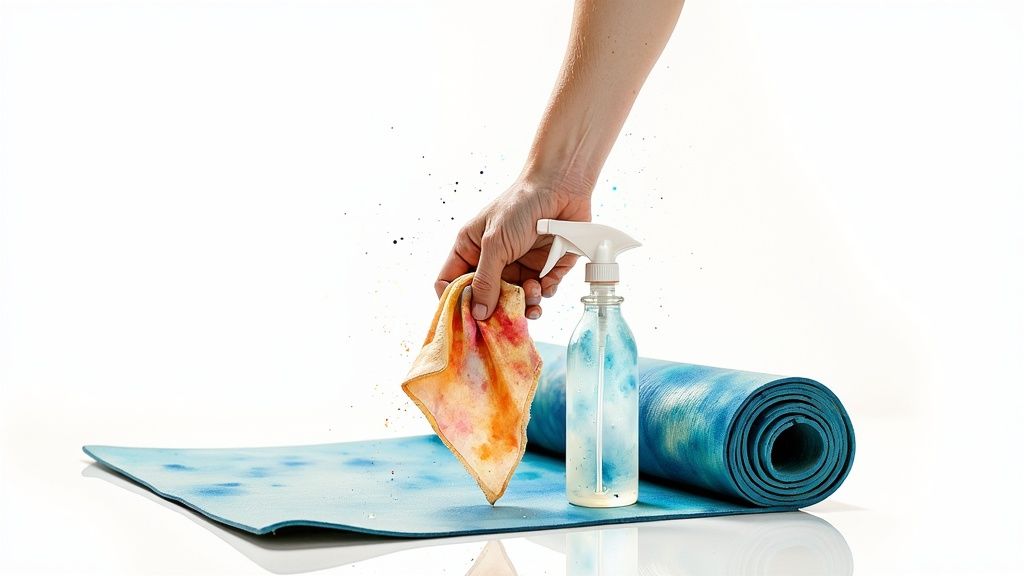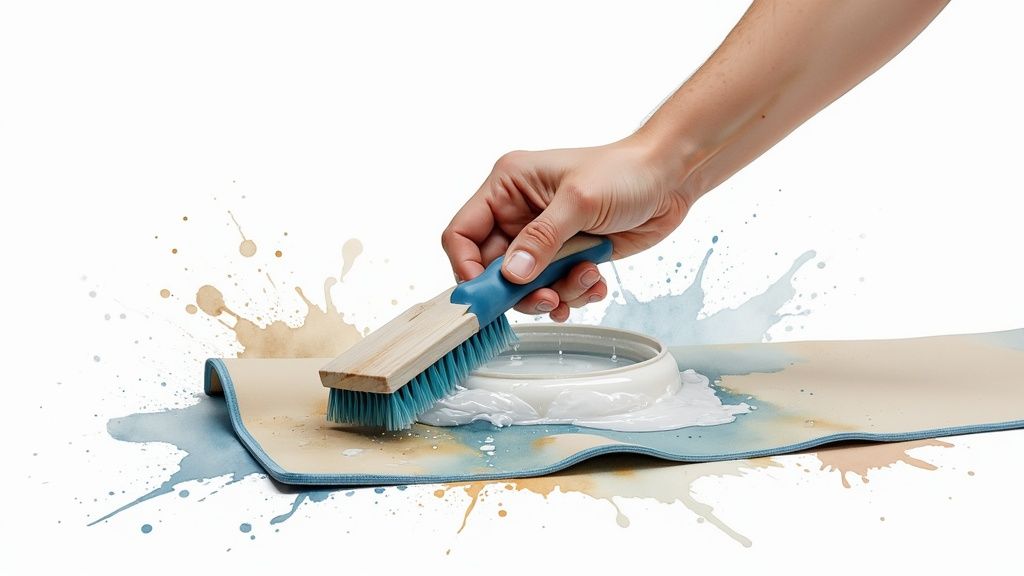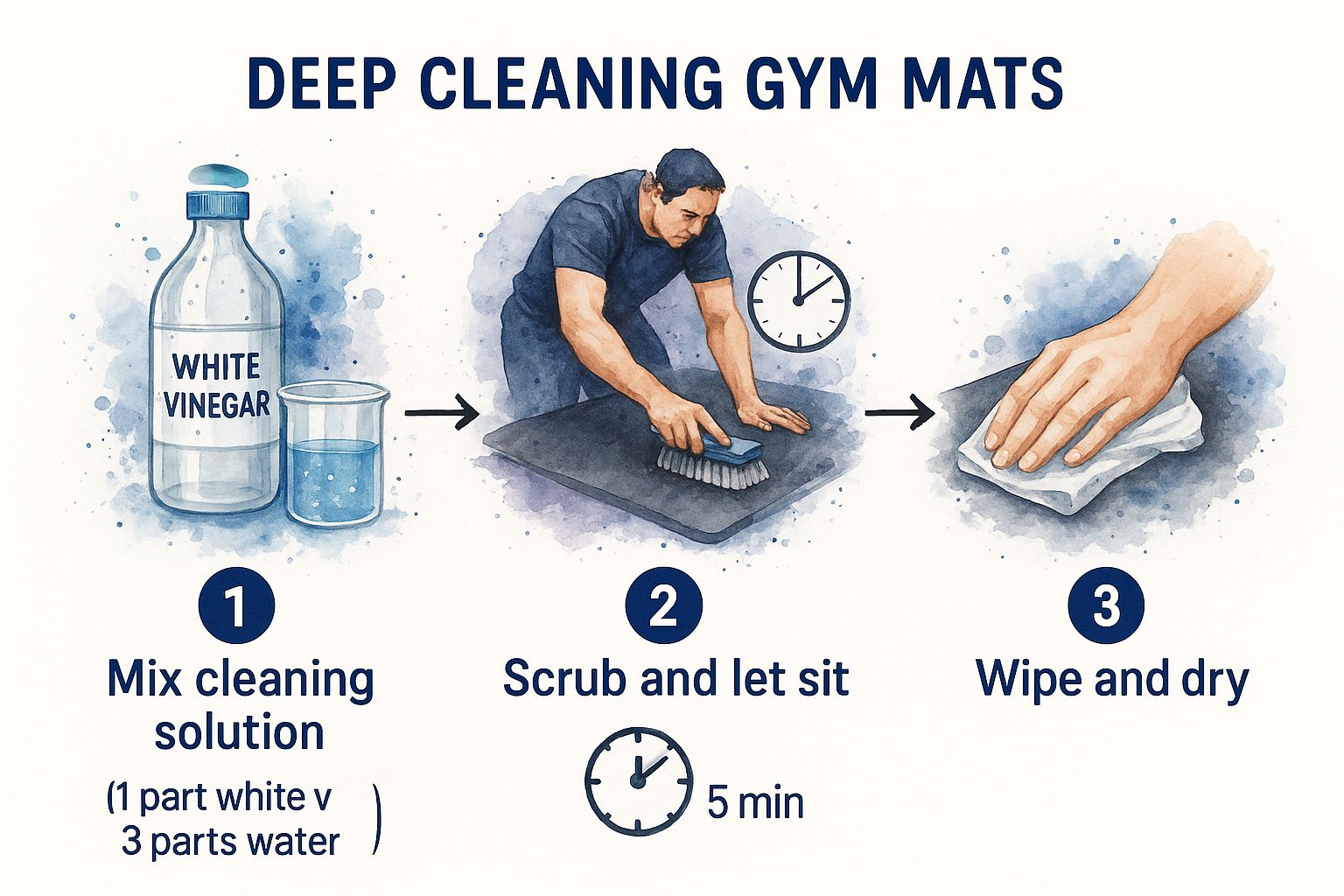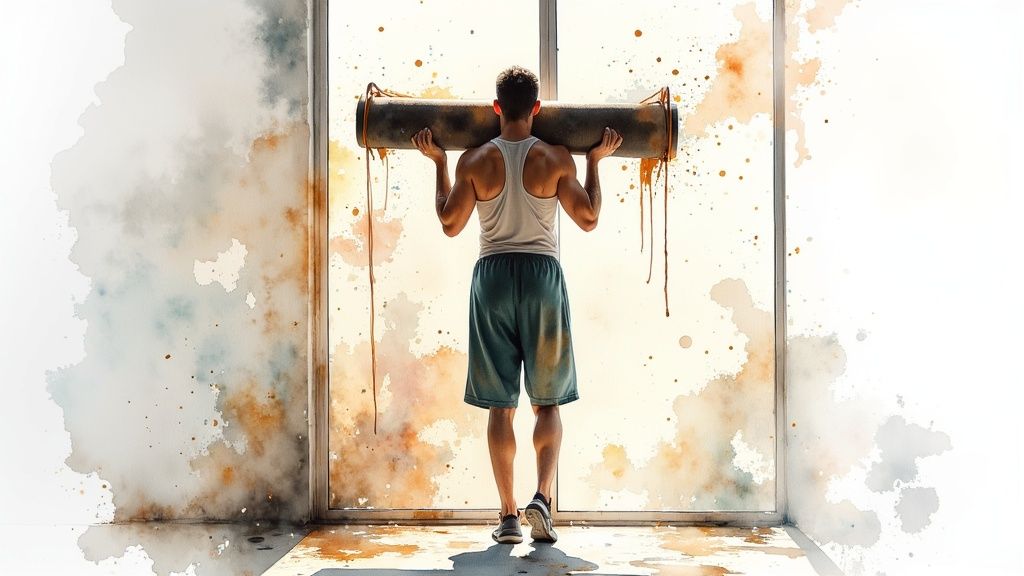To effectively clean a gym mat, follow a simple three-step process: first, remove all loose debris like dust or chalk. Second, wash it with a mat-safe cleaning solution. Finally—and this is the most critical part—allow the mat to dry completely before rolling it up or using it again. For any shared gym equipment, you must include a disinfecting step, ensuring the solution sits for its full recommended dwell time to effectively kill germs.
Why Clean Gym Mats Are Your First Line of Defense for Health and Safety
A dirty gym mat is far more than just an aesthetic issue; it’s a hidden health hazard. Every time someone sweats, kneels, or places their hands on a mat, they leave behind a microscopic cocktail of bacteria, body oils, and skin cells. Without consistent and proper cleaning, you are essentially creating a perfect environment for harmful pathogens to thrive.
This isn't about perfectionism—it's about fundamental safety and risk management. Neglected mats can easily become breeding grounds for bacteria like Staphylococcus, notorious for causing stubborn skin infections, or the fungi responsible for athlete's foot and ringworm. For a commercial gym, this isn't just a hygiene issue; it's a serious liability that can tarnish a hard-earned reputation.
The Business Case for Impeccable Hygiene
In today's fitness industry, a high standard of cleanliness is a non-negotiable core expectation. This shift is so significant that the global market for professional gym cleaning services was valued in the hundreds of millions of USD in 2023 and continues to grow. This trend highlights the rising consumer demand for professional-grade hygiene on shared surfaces like mats. You can learn more about the growth of professional gym cleaning services and what it signals for the industry.
This heightened awareness means your members are paying close attention. A visibly clean facility directly impacts your business by:
- Building Member Trust: A clean space sends a clear message that you prioritize member well-being, which is the foundation of loyalty. For example, a new member choosing between two gyms is more likely to sign up at the one where they see staff actively wiping down equipment, as it signals a commitment to their safety.
- Slashing Health Risks: Proactive cleaning is the most effective way to prevent the spread of germs, protecting everyone who enters your facility. This reduces the risk of community-acquired infections, safeguarding both your members and your business's reputation.
- Extending Mat Lifespan: Regular cleaning does more than sanitize. It prevents the corrosive buildup of sweat and oils that break down mat materials over time, safeguarding your financial investment and ensuring equipment lasts longer.
Actionable Takeaway: For commercial gyms, frame your cleaning protocols as a key feature. A sign at the entrance stating, "For your safety, all mats are disinfected daily with a 10-minute dwell time," turns a routine task into a powerful marketing message about your brand's commitment to health.
Ultimately, knowing how to clean gym mats correctly is an essential skill. It's the first and most important step in creating a workout environment that is safe, welcoming, and truly professional, benefiting both your members' health and your bottom line.
The Pre-Clean That Makes All the Difference
It’s tempting to immediately spray a mat with disinfectant, but applying cleaner to a surface covered in dust and chalk is a common mistake. This doesn't clean effectively; it just creates a gritty paste. Disinfectants are formulated to kill germs on an already cleared surface, not to penetrate layers of physical grime.
Therefore, a proper pre-clean isn't just a suggestion—it's the critical first step. This initial pass removes loose debris: dust, dirt, hair, and chalk residue. If you skip this, your disinfectant will not make full contact with the mat's surface where bacteria and fungi are located, rendering your efforts ineffective.

Practical Ways to Get Rid of Debris
Your approach to pre-cleaning should be tailored to your specific environment and mat type. You wouldn’t use the same method for a single yoga mat as you would for a large commercial gym floor. Here’s how to do it right:
- For Personal Mats: A vigorous shake outside is often sufficient to dislodge daily dust. For any remaining particles, a quick wipe with a dry microfiber cloth is highly effective.
- For Large Interlocking Floors: A soft-bristled broom or a vacuum with a soft brush attachment is your best tool. Avoid stiff, aggressive bristles, as they can scratch and damage the mat's surface over time, creating tiny crevices where more dirt can hide.
Real-World Example: A commercial cross-training gym cut its deep-cleaning time by 15% by implementing a simple "pre-sweep" policy. Before evening disinfecting, staff perform a quick sweep of the matted areas. This small change allows the disinfectant to work more efficiently, making the entire process faster and more effective.
This proactive approach also applies to fresh spills and scuff marks. Quickly blotting a spot with a damp cloth can prevent it from setting and becoming a permanent stain. This kind of immediate action is a cornerstone of effective floor mat cleaning and maintenance. Think of this prep work not as a chore, but as the secret to achieving a genuinely clean and sanitized surface.
Matching Your Cleaner to Your Mat Material
Using the wrong cleaner on a gym mat can cause irreversible damage, such as cracking, discoloration, or creating a dangerously slippery surface. Not all mats are made from the same material, and a one-size-fits-all approach is a recipe for disaster. Choosing the right solution is about both cleaning effectively and protecting your investment.

Gym mats are typically made from PVC, rubber, or various foams, and each material has specific care requirements. Using the wrong product not only risks damaging the mat but can also lead to improper sanitation, creating a breeding ground for athlete's foot or staph infections.
Actionable Guide to Cleaning Different Mat Types
To keep your mats in top condition, you must tailor your cleaning agent to the material. Here’s a simple guide:
-
Closed-Cell Foam & TPE Mats (Yoga, Pilates, Exercise): These non-porous mats are sensitive to harsh chemicals.
- How-To: Use a gentle, pH-neutral cleaner. A simple homemade solution of one part white vinegar to three parts water in a spray bottle works perfectly.
- Benefit: This prevents the foam from breaking down and becoming brittle, preserving the mat's cushioning and lifespan. Avoid bleach or ammonia, which will cause damage.
-
Natural Rubber Mats: Known for their grip and eco-friendliness, they require specific care.
- How-To: Avoid harsh degreasers or excessive soap, which can strip the natural oils and ruin the grip. Use a damp cloth with a specialized rubber mat wash or a highly diluted vinegar solution.
- Benefit: This maintains the mat's signature stickiness and prevents it from drying out, ensuring a safe, non-slip surface for users.
-
PVC (Vinyl) Mats: These are the durable workhorses of the fitness world.
- How-To: These mats can handle more aggressive cleaning. Most standard gym disinfectants and commercial cleaners are safe for vinyl.
- Benefit: For a busy commercial setting, a vinyl-safe disinfectant spray offers an efficient and effective way to maintain hygiene without damaging the robust material.
Actionable Takeaway: Before using any new cleaning product, perform a patch test. Apply a small amount to an inconspicuous area, like the corner or underside of the mat. Let it dry completely and check for any discoloration or texture changes. This simple five-minute test can prevent costly damage to your equipment.
Remember, the physical properties of a mat are just as important as its surface. For example, harsh chemicals can compromise the cushioning of an anti-fatigue mat, defeating its purpose. You can learn more about the link between anti-fatigue mats and your health. By matching your cleaner to the material, you ensure every mat remains safe, hygienic, and functional.
A Practical Guide to Disinfecting and Drying
After clearing away surface debris, the real work of sanitization begins. Cleaning removes visible dirt, but disinfecting neutralizes the harmful bacteria and viruses you can't see. Applying your chosen disinfectant correctly is more than a quick spray-and-wipe; it's about giving the solution enough time to work.
This critical window is known as dwell time—the period a disinfectant must sit wet on a surface to effectively kill pathogens. Wiping the solution away too soon severely reduces its effectiveness, meaning you're not truly sanitizing the mat.
Real-World Example: A yoga studio eliminated member complaints about skin irritation by enforcing a strict 5-minute dwell time for their mat cleaner. Previously, staff would spray and immediately wipe, which didn't give the disinfectant enough time to kill bacteria. This simple change in process led to a healthier environment and happier clients.
The Critical Drying Phase: Your Final Step to Hygiene
Once the dwell time is complete, the final and most crucial step is ensuring the mat is 100% dry before it's used or stored. A damp mat is a perfect breeding ground for mold, mildew, and bacteria. This not only creates foul odors but also completely negates your cleaning efforts. Proper drying is non-negotiable for true hygiene.
This infographic breaks down the deep cleaning process, highlighting the importance of contact time.

Effective cleaning requires patience during the dwell and drying stages. Here are actionable tips for effective drying:
- Hang It Up: For personal yoga or exercise mats, drape them over a chair, railing, or designated mat hanger. This allows air to circulate freely on both sides, preventing moisture pockets. Never fold a damp mat.
- Use Air Movers: In a commercial gym with large matted areas, industrial fans or air movers are essential. They drastically speed up drying time, getting your floors back in service faster and preventing moisture from settling.
- Wipe Thoroughly: After the disinfectant's dwell time, use a clean, dry microfiber cloth to wipe up any excess solution before leaving the mat to air-dry. This removes residual moisture and cleaner.
These final steps are just as important as the initial cleaning. This core principle of moisture removal for hygiene applies to all types of flooring, which you can read more about in our guide on how to keep your entrance mat clean.
Building a Long-Term Mat Maintenance Routine
The most effective way to manage cleaning is to be proactive. Instead of reacting to grime, a consistent maintenance routine extends the life of your mats and ensures they are always safe and ready for use. This is about creating simple, sustainable habits that embed hygiene into your gym's culture.
A great starting point is establishing preventative rules. One of the most impactful policies is a strict "no street shoes" rule on matted areas. This simple change dramatically reduces the amount of dirt, bacteria, and debris tracked in from outside, making every cleaning session easier and more effective.

Creating a Sustainable Cleaning Schedule
So, what does a practical routine look like? It should be based on usage frequency.
-
Daily Tasks (Commercial Gyms): High-traffic mats require daily attention.
- How-To: At the end of each day, wipe down all shared mats with a proper disinfectant, strictly observing the product's recommended dwell time. Place "Wet Floor" signs during the process.
- Benefit: This prevents the overnight proliferation of bacteria and ensures a fresh, hygienic surface for members the next morning.
-
Weekly Deep Clean (All Mats):
- How-To: Once a week, perform a more thorough scrubbing. This tackles the built-up sweat, oils, and grime that a quick daily wipe might miss. For a personal mat, this might be your only cleaning session.
- Benefit: A weekly deep clean restores the mat's surface, removes stubborn residues, and prevents long-term material degradation.
Proper storage is a critical, often-overlooked part of mat maintenance. Always hang mats on dedicated racks or hooks that allow for free air circulation. Stacking damp or freshly used mats creates a perfect environment for mildew and bacteria, undermining all your cleaning efforts.
Real-World Example: A boutique fitness studio invested in wall-mounted mat hangers instead of a storage bin. This simple change ensured mats dried properly after cleaning, eliminated musty odors, and visually reinforced the studio's commitment to cleanliness and order.
This commitment is crucial, especially with the global exercise mat industry valued at over USD 10 billion in 2023, reflecting how many people rely on these surfaces. Consistent upkeep also brings other key advantages, like the comfort and safety we cover in our guide on anti-fatigue mat benefits.
Your Top Gym Mat Cleaning Questions, Answered
Even with a solid routine, specific questions inevitably arise. Getting clarity on these common issues will help you clean with confidence and keep your mats in excellent condition for years. Let's tackle the most frequent questions.
First, how often should you really deep clean? For a personal mat used a few times a week, a deep clean every 1-2 weeks is sufficient. However, in a busy commercial gym, high-traffic mats must be deep cleaned daily to maintain proper hygiene. All shared mats should be disinfected after every single use—no exceptions.
Tackling Odors and Product Safety
A common question is about using bleach for a "deep" clean. The answer is a definitive no. Bleach is extremely harsh and will destroy most mat materials, including foam and rubber. It causes them to become brittle, crack, and fall apart. Always opt for a pH-neutral cleaner or a diluted vinegar solution for a safer, yet effective, clean.
What about a stubborn, funky smell that won't go away? This is a classic sign of bacteria buildup within the mat.
Actionable Takeaway: To eliminate odors, first clean the mat with a 50/50 mixture of white vinegar and water and let it air dry completely—do not rush this step. If the smell persists, sprinkle a generous layer of baking soda over the dry mat. Let it sit for 20-30 minutes to absorb the odors, then vacuum or wipe it off. This two-step process neutralizes the odor-causing bacteria and then absorbs any lingering smells.
Finally, resist the urge to put your mat in the washing machine. While it seems like a quick fix, the machine's aggressive agitation can tear the material, and the heat from a dryer will likely warp or even melt it. Hand-washing is the only recommended method to protect your mat’s structural integrity and grip for the long term.
At Mats4U, we know a clean, safe environment starts from the ground up. Explore our wide selection of high-quality entrance, anti-fatigue, and commercial mats designed for durability and easy maintenance. Visit us at https://www.mats4u.com to find the perfect solution for your space.







